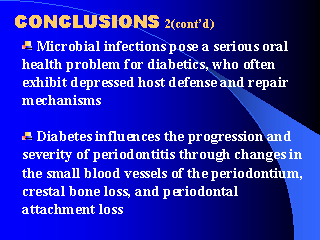|
|
|
|
front |1 |2 |3 |4 |5 |6 |7 |8 |9 |10 |11 |12 |13 |14 |15 |16 |17 |18 |19 |20 |21 |22 |23 |24 |25 |26 |27 |28 |29 |30 |31 |32 |33 |34 |review |
 |
It has been well demonstrated that these microbes can be responsible for a
number of factors that may be involved in the pathogenesis of periodontal
disease. The factors include a leukotoxin and a chemotaxis-inhibiting factor
that can impair the function of polymorphonuclear leucocytes; a
lipopolysaccharide that can cause bone resorption; and a collagenase that can
destroy gingival connective tissue. It has also been documented that anaerobes
may have increased pathogenicity and may persist for longer periods of time in
diabetics as compared to non-diabetics.
The crevicular space in persons with Type 2 DM can be considered an ideal environment favoring the growth of anaerobic pathogens that have been identified with periodontal disease. The diabetic state is often associated with earlier and severe vascular changes that affect both large and small blood vessels in a variety of tissues, including periodontal tissue. As a result of the vascular changes: the smaller blood vessels are thicker which in turn reduces blood flow; this, then inhibits the diffusion of oxygen as well as obstructs the migration of leukocytes and the diffusion of immune factors to the gingival tissues; hence, creating a more favorable anaerobic environment. Moreover, the periodontal tissues are less able to oxidize glucose and as a result, the crevicular glucose levels are elevated in the Type 2 DM person. These changes would most likely favor the growth of anaerobic pathogens. Investigations of the anaerobic pathogens associated with Type 2 DM demonstrates species of bacteria qualitatively similar to those seen in other forms of periodontal disease. Importantly, however, there is a significant increase in some of the more virulent species such as Bacteroides gingivalis, Bacteroides intermedius, and Wolinella recta. These organisms possess sufficient virulence factors to cause direct tissue damage, especially when they are seen in high numbers. This quantitative increase in virulent organisms, which possess tissue-damaging properties, may be the major factor leading to the increased progression of periodontal disease. Hence, it may then be proposed that the Type 2 DM individual's depressed host defense system allows for a shift in virulence potential of the oral microbes, allowing the overgrowth of specific pathogens during periods when the tissue defense mechanisms have been compromised. Research has shown that patients who have certain systemic medical disorders (e.g., Type 2 DM) that may affect the patients' ability to fight infection are most likely to experience bone and attachment loss. This is particularly true in long-term, poorly controlled diabetic patients. The mineral content of bone has been found to be inversely correlated to the fasting level of blood glucose, glucosuria, and insulin requirements. It has been shown, using experimental diabetic rats, that essentially all aspects of bone growth and mineralization are diminished in the absence of insulin. Although the exact role of insulin in bone metabolism is not fully understood, it appears that a number of factors involved in the metabolism of bone are affected by the insufficiency of insulin. Moreover, patients with a history of bone and attachment loss are at higher risk for further breakdown, and older patients have more attachment loss than younger patients, likely due to the accumulative effects of bone and attachment loss over a lifetime. |